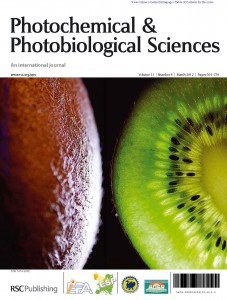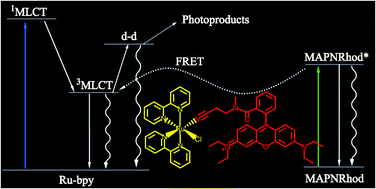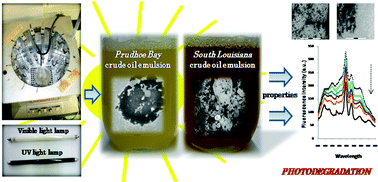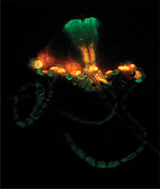 PPS Issue 5 is now online and features bioluminescent mushrooms on the cover. This image highlights the article from Cassius Stevani and co-workers from Brazil and the USA which provides evidence that a single bioluminescent system is shared by all known bioluminescent fungal lineages. Click here to read the full issue.
PPS Issue 5 is now online and features bioluminescent mushrooms on the cover. This image highlights the article from Cassius Stevani and co-workers from Brazil and the USA which provides evidence that a single bioluminescent system is shared by all known bioluminescent fungal lineages. Click here to read the full issue.
Bioluminescence has evolved independently at least 40 times in different lineages of organisms. Although all luminous systems involve the catalytic oxidation of a substrate (a luciferin) by a respective enzyme (a luciferase) or photoprotein the luciferases are not all homologous and each luminescence system has a luciferin with a specific structure. Therefore each system is commonly only found within a single lineage.
Although fungal bioluminescence is a common phenomenon, from the huge diversity in the Kingdom Fungi only 71 species have been verified as bioluminescent and they belong to four distantly related lineages. There has, for a long time been uncertainty about the participation of a luciferase in fungal bioluminescence and only recently did this group prove its involvement confirming the enzymatic nature of bioluminescence (Photochem. Photobiol. Sci., 2009, 8, 1416)
The question that this study addresses is whether the mechanism of bioluminescence is the same in all four evolutionary lineages, or whether each lineage has a unique mechanism for light emission implying independent origins. Cross-reactions in all possible combinations of hot (substrate/luciferin) and cold (enzyme/luciferase) water extracts from species representing each of the four bioluminescent lineages resulted in light emission. In comparison, cross-reactions of these extracts with extracts from closely related non-luminescent species yielded no light emission. These results suggest that all lineages share a single luminescent pathway and that this arose early in the evolution of the mushroom-forming order Agaricales.
Read the full article by clicking on the link below. Free to read for 6 weeks!
Evidence that a single bioluminescent system is shared by all known bioluminescent fungal lineages
Anderson G. Oliveira, Dennis E. Desjardin, Brian A. Perry and Cassius V. Stevani
Photochem. Photobiol. Sci., 2012, 11, 848-852 DOI: 10.1039/C2PP25032B
You can keep up to date with the latest developments from PPS by signing up for free table of contents alerts.













 In a recently published PPS article a team from Argentina demonstrate a way to enable a photodissociation reaction at longer wavelengths by utilising a modified rhodamine B (Rhod) cooridinated to a bis-bipyridine ruthenium (II) (Ru-bpy) phototrigger complex which has enhanced absorption of green light.
In a recently published PPS article a team from Argentina demonstrate a way to enable a photodissociation reaction at longer wavelengths by utilising a modified rhodamine B (Rhod) cooridinated to a bis-bipyridine ruthenium (II) (Ru-bpy) phototrigger complex which has enhanced absorption of green light. 
 What if you could disperse oil spills in the sea, such as the BP spill in the Gulf of Mexico, with air, sunlight, and an environmentally friendly botanical product? These are the ingredients used in a recently published article from Professor Steven Suib and his team from the University of Conneticut, USA. The study found that by adding a plant-based surfactant to a sample of synthetic seawater mixed with crude oil, pumping in air, stirring the sample and exposing it to ultraviolet light, the oil/water mixture quickly broke down into small particles.
What if you could disperse oil spills in the sea, such as the BP spill in the Gulf of Mexico, with air, sunlight, and an environmentally friendly botanical product? These are the ingredients used in a recently published article from Professor Steven Suib and his team from the University of Conneticut, USA. The study found that by adding a plant-based surfactant to a sample of synthetic seawater mixed with crude oil, pumping in air, stirring the sample and exposing it to ultraviolet light, the oil/water mixture quickly broke down into small particles.
 A team from Austin, Texas have reported two new proteins displaying primary structures never before encountered in natural FPs in a recently published PPS article. The proteins consist of multiple GFP-like domains repeated within the same polypeptide chain. A two-domain green FP (abeGFP) and a four-domain orange-fluorescent FP (Ember) were isolated from the siphonophore Abylopsis eschscholtzii and an unidentified juvenile jellyfish (order Anthoathecata), respectively.
A team from Austin, Texas have reported two new proteins displaying primary structures never before encountered in natural FPs in a recently published PPS article. The proteins consist of multiple GFP-like domains repeated within the same polypeptide chain. A two-domain green FP (abeGFP) and a four-domain orange-fluorescent FP (Ember) were isolated from the siphonophore Abylopsis eschscholtzii and an unidentified juvenile jellyfish (order Anthoathecata), respectively. 

